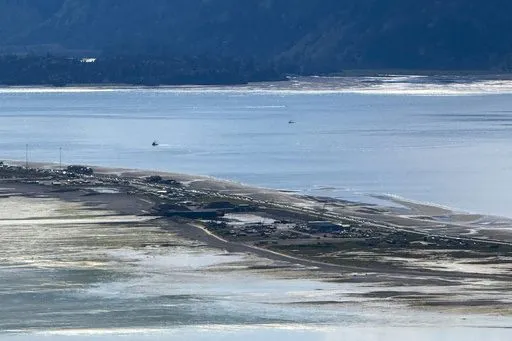Overview
On Wednesday, Alaska experienced a significant seismic event, registering a magnitude of 7.3, which sent shockwaves not only through the earth but also through the coastal communities of the state. The initial alarm brought with it a tsunami warning for areas south of Sand Point, only to be later canceled as assessments determined that the risk of a tsunami had diminished. This earthquake, occurring in a region known for its tectonic activity, raises concerns and curiosity about the nature of seismic events in Alaska and their potential impact.
Alaska: The Earthquake Capital of the United States
Alaska earns its title as the most earthquake-prone state in the US due to its unique geological positioning along the Pacific Ring of Fire. This area is characterized by a high concentration of tectonic plate boundaries, volcanic activity, and seismic events. The primary culprit behind Alaska’s seismic activity is the complex interaction between the Pacific Plate and the North American Plate. The convergence of these plates often leads to powerful earthquakes, making preparedness and understanding of seismic risks critical for residents and infrastructure.
Details of the M7.3 Earthquake
The earthquake that struck near Sand Point on Wednesday was categorized as significant due to its magnitude and the population density in the surrounding areas. Initially recorded at 7.3 on the Richter scale, it caused localized shaking that was felt across a wide geographic area. Fortunately, after careful monitoring, authorities were able to cancel the tsunami warning, which prevented panic and further disruption to communities that often bear the brunt of such natural disasters.
Geo-Location and Depth
The earthquake’s epicenter was located approximately 76 miles south of Sand Point, a small city on Popof Island within the Aleutian Chain. The depth of the quake was approximately 28 miles beneath the seafloor, which plays a significant role in determining the level of ground shaking experienced on the surface. Shallower earthquakes typically produce stronger surface shaking, increasing the chance of damage, while deeper quakes tend to dissipate energy before reaching populated areas.
The Tsunami Risk: Understanding the Alerts
Tsunamis are often the most feared collateral consequence of underwater earthquakes. The rapid displacement of water by seismic activity can trigger massive waves that move across the ocean at high speeds. Following the Sand Point earthquake, the Alaska Tsunami Warning Center issued a precautionary warning, an essential protocol designed to protect lives in coastal regions. However, scientists and experts analyze data quickly, and it was determined that the potential for a tsunami was minimal, leading to the cancellation of the alert.
How Tsunamis Are Generated
Tsunamis are typically generated when tectonic plates shift in such a way that they displace large volumes of water. The severity and reach of the tsunami can depend on several factors, including the earthquake’s depth, magnitude, and location in relation to the coast. The canceled tsunami warning following the Sand Point earthquake indicates that while the quake was significant, the conditions necessary for a damaging tsunami were not present.
The Historical Context of Earthquakes in Alaska
To fully grasp the importance of this recent earthquake, one must consider Alaska’s seismic history. The state has experienced numerous high-magnitude earthquakes, with the 1964 Good Friday earthquake still holding the record as the most powerful quake ever recorded in North America, measuring 9.2. This event resulted in significant loss of life and widespread damage, serving as a stark reminder of the raw power of nature. In recent years, Alaska has also seen increased seismic activity, raising questions about whether this is part of a long-term trend affecting the region.
Preparedness and Safety Protocols
Given its vulnerability to earthquakes and tsunamis, Alaska has developed extensive preparedness measures to ensure the safety of its residents. These measures include educational programs, regular earthquake drills, and the establishment of early warning systems. The state also invests in research to better understand seismic activity and its implications. Such initiatives aim to create a culture of preparedness among Alaskans, reducing the potential for disaster when the ground starts to shake.
Impact on Local Communities
While the 7.3 magnitude earthquake may not have led to immediate damage, its psychological impact on communities cannot be overlooked. Alaskans live with the understanding that the ground beneath their feet can shift dramatically at any moment. When earthquakes occur, even with minimal consequences, they serve as reminders of the ever-present threat. The aftermath of seismic events often leads to increased anxiety and preparedness efforts in communities directly impacted.
Community Responses to Earthquakes
Residents in earthquake-prone areas often talk about their experiences during seismic events, sharing stories that highlight individual reactions to the tremors. From securing furniture to developing family emergency plans, Alaskans are known for their resilience and adaptability when faced with challenges posed by their environment. Businesses and local governments also play a role in cultivating a preparedness mindset through continuous training and public awareness campaigns.
Conclusion: Learning from the Past
The recent magnitude 7.3 earthquake south of Sand Point should remind residents and observers alike of the lessons learned from earthquakes past. While Alaska’s geological activity is a reality of life in the region, the capacity for human preparedness and response can significantly mitigate the risks involved. Following the cessation of the tsunami warning, communities can reflect on their policies and procedures while continuing to engage in effective preparedness practices.
Ultimately, the 2023 Sand Point earthquake serves as a reminder that while natural disasters cannot be prevented, the effects they have can be managed. By fostering a culture of preparedness and respect for the earth’s powerful forces, Alaskans can navigate the challenges posed by their unique environment, ensuring that they remain vigilant, informed, and ultimately resilient in the face of uncertainty.





